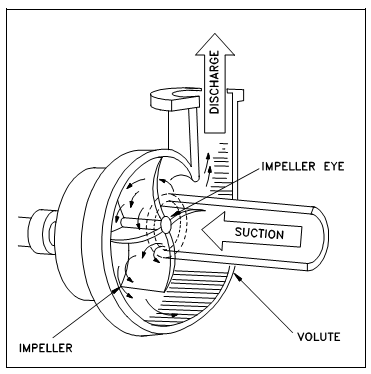Centrifugal Pumps:
Centrifugal pumps essentially consist of a stationary pump casing and an impeller mounted on a rotating shaft. The pump casing gives a pressure boundary for the pump and holds channels to properly direct the discharge and suction flow. A pump casing has suction and discharge penetrations for the major flow path of the pump and generally has small drain and vent fittings to erase gases trapped within the pump casing or to drain the pump casing for manages.
Below figure is a simplified diagram of a classical centrifugal pump which displays the associative locations of the pump impeller, volute, suction, and discharge. The pump casing guides the liquid from the suction links to the center, or eye, of the impeller. A vane of the rotating impeller impart a radial and rotary motion to the liquid and forcing it to the outer periphery of the pump casing whereas it is collected within the outer part of the pump casing known as the volute. The volute is a region which expands within cross-sectional area as it wraps around the pump casing. The reasons of the volute are to collect the liquid discharged from the periphery of the impeller at high velocity and gradually cause a reduction in fluid velocity through raising the flow area. That will convert the velocity head to static pressure. The fluid is then discharged from the pump by the discharge connection.

Figure: Centrifugal Pump